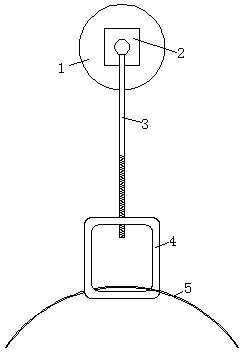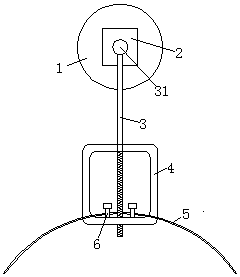Impacted tooth traction apparatus
A traction device and technology of ambush teeth, applied in dentistry, orthodontics, dental prosthetics, etc., can solve the problems of difficulty in controlling the action point and direction of traction force, high bonding failure rate, and increasing attachment failures, etc. To achieve the effect of convenient surgical suture, small wound, and improve the success rate of bonding
- Summary
- Abstract
- Description
- Claims
- Application Information
AI Technical Summary
Problems solved by technology
Method used
Image
Examples
Embodiment 1
[0033] Such as figure 1 As shown, a traction device for an impacted tooth in this embodiment includes a base plate 1, a fixed block 2, a connecting rod 3 and a traction ring 4, the base plate 1 is used to connect with an impacted tooth, and is directly bonded by a light-curing adhesive On the tooth surface of the ambush tooth; the fixed block 2 is fixed on one side of the base plate 1, the fixed block 2 is made of metal material in this embodiment, one end of the connecting rod 3 is hinged on the fixed block 2, and the other end is provided with One end of the traction ring 4 is provided with a first threaded hole 41, the fixed block 2 is connected with the first threaded hole 41 of the traction ring 4 through threads, the traction ring 4 is rotated, and the traction ring 4 approaches or moves away from the bottom plate 1 along the connecting rod 3 move.
[0034] The traction device for the buried teeth of this embodiment uses the bottom plate 1 to connect with the buried tee...
Embodiment 2
[0036] Such as figure 2 As shown, the structure of the retraction device for embedded teeth in this embodiment is basically the same as that in Embodiment 1, the difference is that the traction ring 4 is provided with a second threaded hole 42 at the end opposite to the first threaded hole 41, and the The first and second threaded holes are located on the same straight line, and the connecting rod 3 can be connected with the first and second threaded holes in turn, such as image 3 with Figure 4 shown.
[0037] In this embodiment, the traction ring 4 is provided with two connecting nails 6 inside the end where the second threaded hole 42 is provided, and the two connecting nails 6 are symmetrically arranged on both sides of the second threaded hole 42 . The connecting nail 6 is used to connect with the arch wire 5 of the auxiliary arch, combined with Figure 5 As shown, one end of the arch wire 5 penetrates from the side of the traction ring 4, passes through the side of ...
Embodiment 3
[0042] Such as Figure 9 As shown, the structure of the traction device for embedded teeth of this embodiment is basically the same as that of Embodiment 2, except that the traction ring 4 includes a ring body 43 and a cylinder 44 fixed at one end of the ring body 43, and the cylinder body 44 is provided with the internal thread that matches with connecting rod 3. The ring body 43 is fixed with a connecting nail 6 inside the end opposite to the cylinder 44. In this embodiment, only one connecting nail 6 is required, so the width of the traction ring 4 can be further reduced, which is convenient for use.
PUM
 Login to View More
Login to View More Abstract
Description
Claims
Application Information
 Login to View More
Login to View More - R&D
- Intellectual Property
- Life Sciences
- Materials
- Tech Scout
- Unparalleled Data Quality
- Higher Quality Content
- 60% Fewer Hallucinations
Browse by: Latest US Patents, China's latest patents, Technical Efficacy Thesaurus, Application Domain, Technology Topic, Popular Technical Reports.
© 2025 PatSnap. All rights reserved.Legal|Privacy policy|Modern Slavery Act Transparency Statement|Sitemap|About US| Contact US: help@patsnap.com



